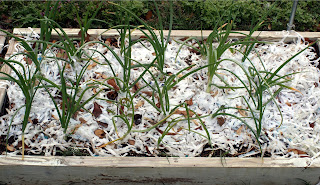It’s been close to a month now since I planted thirty six
yellow onion sets in a small raised bed on March 2, 2013. They are part of an
experiment to chronicle how close to a perfect onion I can get. In past years,
I’ve been frustrated in that many of my onions failed to significantly bulb up,
while others bolted early on in the growing cycle. (See my ‘Onions are Easy to Grow’ video for some
idea of how they have often looked)! The prior post can be found here.
For this experiment, I’ve used a loose soil and made sure to
keep the plants well watered early on. I’ll need a cool spring too, for the best growing
performance envelope, although I won’t be able to control that.
 The planting grid I used here followed advice I found on the Internet that
suggested each onion set be placed in columns spaced four inches apart with
rows separated by six inches. Here is what that planting grid looked like pictured at
right.
The planting grid I used here followed advice I found on the Internet that
suggested each onion set be placed in columns spaced four inches apart with
rows separated by six inches. Here is what that planting grid looked like pictured at
right.
The weather, especially during the last couple of weeks of March was
much colder than normal and so not much growth occurred. However, just
recently, it’s begun to warm up nicely and good rates of growth have ensued. This
picture at the top is a close up of a few of the larger plants (pictured are cells
12, 22 and 32). As you can see all of these sets are healthy in appearance with the 'large' set at top looking the largest. The only 'problem sets' consisted of a missing set in cell 26 (it was replaced) and a set that got somehow inverted - this was also corrected.
 |
| Scale is in centimeters |
I measured each onion plant in terms of gross height just for
comparison purposes. Row 1 consisted of the largest sets while rows 2-4 were
medium in size. The bottom rows (5 & 6) contained the smallest sets of the
lot.
Interestingly, after I graphed out the results, I noted that most of the plants were relatively equal in size (± 2-3 cm)
with the exception of the really large sets.
So, everything is growing nicely. My next update will be on or around the end of April 2013.
May 8, 2013 Update: Well it's been about 60 days since I planted the onion sets and as you can see, they have grown quite a bit. At this time, I haven't seen any evidence of bulbing. The lower stem portions of some of the onions measured about 12 mm across.
May 22, 2013 Update: A fourth onion (cell # 4-4) had bolted and was harvested on this date. The other three had bolted a week earlier and all of those were from the 'large' sized onion sets. This one was from the 'medium' sized sets. Of note too is another onion experiment that was started on the 17th of March of which there are also 25 plants - none of these have bolted. All the onions are about the same sized and none have shown any inclination to bulb up even as this experiment is entering the 80th day.
August 18, 2013 Update: I've been pulling onions out of this space for a couple of weeks now with plenty more to go. The average size was fairly small weighing in at about 43 grams. The picture here of three peeled onions weighed in at 130 grams. These guys, though small, were still a good investment as I have plenty to use for the next couple of months.
 |
| Click on to enlarge |
May 22, 2013 Update: A fourth onion (cell # 4-4) had bolted and was harvested on this date. The other three had bolted a week earlier and all of those were from the 'large' sized onion sets. This one was from the 'medium' sized sets. Of note too is another onion experiment that was started on the 17th of March of which there are also 25 plants - none of these have bolted. All the onions are about the same sized and none have shown any inclination to bulb up even as this experiment is entering the 80th day.
August 18, 2013 Update: I've been pulling onions out of this space for a couple of weeks now with plenty more to go. The average size was fairly small weighing in at about 43 grams. The picture here of three peeled onions weighed in at 130 grams. These guys, though small, were still a good investment as I have plenty to use for the next couple of months.






